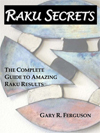|
- Article - Site Navigation Home Raku Artist Bio Raku Gallery Free Raku Glazes Raku Define Raku Links Raku Articles Raku Books |
Robert Piepenburg Workshop I - ThrowingI had an opportunity last month to attend a one-day workshop with one
of the more famous Raku potters - Robert Piepenburg. He is the author of
two clay books: I will cover this workshop over the next 3 or 4 issues because there was a lot of good information shared during the day. This month's article will cover how he throws clay, shapes, and trims clay on the wheel. First, Piepenburg noted the stool height should be as high as the wheel head so that your legs can be straighter out to improve circulation. When throwing he pulls the walls using a sponge in the outside hand. Later when he is shaping the piece, he uses a rib on the outside and moves to using the sponge on the inside. He generally leaves a fairly thick bottom on smaller pieces, which he later trims to shape. He thickens the rim after each pull, which helps keep the pot on center and finally he carves small chunks out of the top of the rim and them smoothes with a sponge to add interest to the rims of the pieces. Piepenburg had some interesting tips for throwing tall pieces. First, if you are going to throw a tall piece start with a tall centered mound. This starts the wall out higher to begin with. He then throws from the top down. This involves pulling up the first top inch or so of the wall. Then pulling up the next lower top inch, and then the next until the last pull starts from the bottom. This was a technique I had not heard of before nor tried yet. He also noted that is was important to have narrow throwing marks on a tall piece because narrow throwing marks are the sign of a strong wall. Next he gave thoughts on throwing a bulbous form. Since a bulbous form is unstable in wet clay the form has to be thrown in stages allowing the piece to partially dry or the piece can be quickly dried using a blowtorch or heat gun so the walls can be pushed out and shaped safely. When trimming a piece he usually uses a push pin(s) pushed through the sides and bottom of the pot to gauge how much has been removed during the trimming process. When the trimming tool start hitting the pin tip, he knows to stop trimming. He also places a baby food jar lid on the bottom of the pot to place his finger on to help stabilize the pot when trimming the sides of the pot. He lets the sides and top dry so the bottom can be trimmed. Once the bottom is trimmed, he softens the sides and top again by placing wet paper towels around the pot and covers it with a plastic bag for between 30 to 60 minutes. This makes the walls pliable again. Piepenburg likes to make marks and distort the piece once it has been formed and trimmed. His favorite technique is to press a piece of wood molding into the pot from a variety of angles and twists. He then pushes out from the inside where the mark was made to return "energy" back to the piece.
|
||
|
Books
Learn Dozens of Hints, Tips and Techniques in the free monthly newsletter Just
Raku Privacy Policy - Your email address or other personal information will only be used for this newsletter. It will never be given, rented, or sold to any other party for any other purposed. |
||
|
Gary R. Ferguson - Raku Artist (c) Copyright 2005, Gary R. Ferguson |
||



